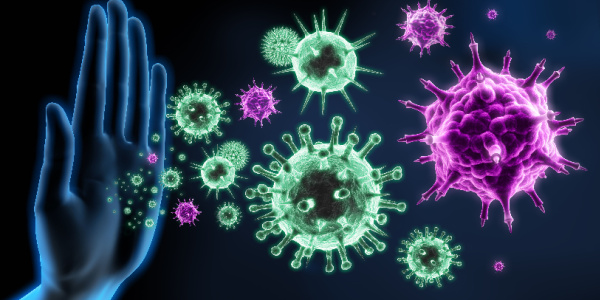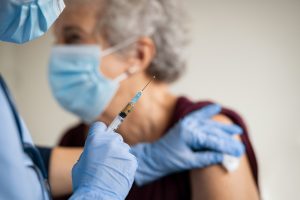In older people, newly introduced pathogens can gain the upper hand frighteningly quickly. Unfortunately, vaccination is not as effective in this age group as it is in younger people. Now a study in mice conducted by Stanford Medicine and the National Institutes of Health’s Rocky Mountain Laboratories provides tantalizing evidence that it may one day be possible to boost the immune systems of older people with a one-time treatment that modifies the composition of one type of immune system modulated. Ross and Lara Myers, PhD, a research scientist at Rocky Mountain Laboratories, are the lead authors of the study, which is published in Nature. Irving Weissman, MD, professor of pathology and developmental biology, and Kim Hasenkrug, PhD, head of the Division of Retroviral Immunology at Rocky Mountain Laboratories, are the senior authors of the research.
A Shift in the Immune System Causes Older People to Respond Less Well to Vaccinations
The target cells are a subgroup of so-called hematopoietic stem cells (HSC). HSCs are the grandfathers of the immune system and form the origin of all other types of blood and immune cells, including B and T cells, collectively known as lymphocytes. As we age, our HSCs begin to favor the production of other immune cells, called myeloid cells, over lymphocytes. This shift affects our ability to fully respond to new viral or bacterial threats and makes our response to vaccinations much less robust than that of younger people.
Older people simply do not produce many new B and T cell lymphocytes. At the start of the COVID-19 pandemic, it quickly became clear that older people were dying in greater numbers than younger people. This trend continued even after vaccinations became available. If we can revive the aging human immune system, as we did in mice, it could be life-saving when the next global pathogen emerges.
How the Immune System Works
Weissman was the first to isolate HSCs in mice and humans in the late 1980s. Since then, he and his colleagues have studied the molecular details of these cells, meticulously tracing the intricate relationships between the numerous cell types that arise in their wake. Some of these offspring form what is known as the adaptive immune system: highly specialized B and T lymphocytes, each of which recognizes only a particular three-dimensional structure—perhaps a pointy piece here or a telltale gnarled lump there—that gives away an invading virus or bacteria. Like trained assassins, once they recognize their target, B lymphocytes produce antibodies that attach to the telltale structures and target infected or foreign cells for destruction, while different subtypes of T lymphocytes either destroy infected cells or loudly summon other immune cells to kill them to kill the enemy.
The specificity of B and T lymphocytes enables the immune system to have memory. Once you’ve been exposed to a particular invader, the body reacts quickly and decisively if the same pathogen is seen again. This is the basic concept of vaccination: to trigger an initial reaction to a harmless mimic of a dangerous bacteria or virus. In response, the lymphocytes that recognize the invader produce not only cells that clear the infection but also long-lived memory B and T cells that, in some cases, can last a lifetime. This means the system is prepared if the threat becomes real.
Another important part of our immune system is innate immunity, which is far less differentiated. In the blood, it is operated by a class of cells called myeloid cells. Like janitors at school, these cells scour the body and devour any unknown cells or pieces of waste. They also trigger inflammatory responses that recruit other cells and chemicals to infected sites. Inflammation helps the body protect itself from invaders. However, they can be a major problem if triggered inappropriately or overly enthusiastically, and aging is associated with chronic inflammation in humans.
Back to a Younger Immune System
Ross and Weissman knew from previous research that as we age, the number of HSCs that form a balance of lymphocytes and myeloid cells decreases, while the number of those that are myeloid-influenced increases. This favors the production of myeloid cells. At the beginning of human history, when people rarely left their place of birth and lived shorter lives, this gradual change probably had no consequences (perhaps it was even beneficial), since people were probably exposed to all the pathogens around them by early adulthood and Lymphocytes were protected by their memory. But now it’s clearly detrimental.
The researchers wondered if they could tip the balance back toward a younger immune system by depleting myeloid HSCs and replacing them with more balanced HSCs. Your guess was correct. Mice aged between 18 and 24 months (varies in the mouse world) that were treated with an antibody aimed at destroying myeloid HSCs had more balanced HSCs – and more new, naive B and T lymphocytes – than their untreated peers even several weeks later. These new, naive lymphocytes provide better immune defense against novel infections that people are increasingly experiencing as our world becomes more global. Without this renewal, these new infectious agents would not be recognized by the existing pool of memory lymphocytes. The treatment also reduced some negative consequences, such as inflammation, that can occur when an older person’s immune system struggles with a new pathogen.
Technique for Revitalizing Aging Human Immune Systems
Not only did the researchers see a shift toward cells involved in adaptive immunity, but they also observed a dampening of the levels of inflammatory proteins in the treated animals. They were surprised that a single treatment had such a long-lasting effect. The difference between the treated and untreated animals remained dramatic two months later.
When the treated animals were vaccinated eight weeks later against a virus they had never been exposed to before, their immune systems responded more strongly than those of untreated animals, and they were significantly better able to resist infection by that virus. All features of an aging immune system – functional markers on cells, the prevalence of inflammatory proteins, response to vaccinations and the ability to resist a fatal infection – were influenced by this single treatment that targeted only one cell type. Ultimately, the researchers showed that myeloid HSCs from mice and humans are so similar that it may one day be possible to use a similar technique to revitalize aging human immune systems, potentially making a person less susceptible to novel infections and improving their response to vaccinations is improved.
The study also has interesting implications for stem cell biology and the way HSCs rely on biological niches or specific cellular environments for their longevity and function throughout our lives. Most people in immunology have believed that you lose these types of tissue-specific stem cells as you age. According to the researchers, this is false. The problems arise when you start favoring one type of HSC over another. And they were able to show in mice that this can be reversed. This finding changes the way we think about stem cells at every stage of aging.







